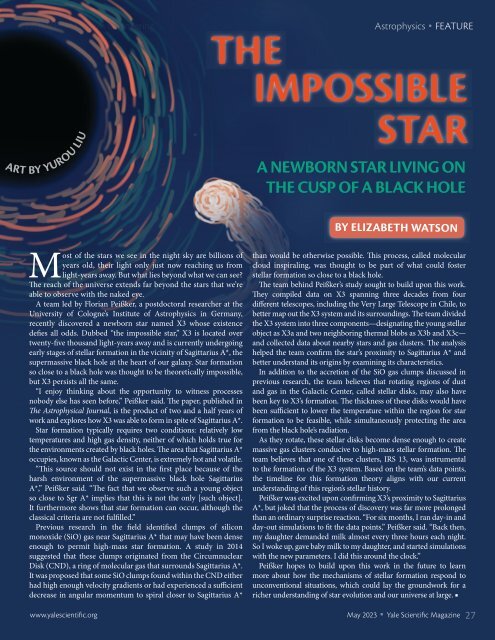YSM Issue 96.2
You also want an ePaper? Increase the reach of your titles
YUMPU automatically turns print PDFs into web optimized ePapers that Google loves.
FEATURE<br />
Materials Engineering<br />
Astrophysics<br />
FEATURE<br />
THE<br />
IMPOSSIBLE<br />
ART BY YUROU LIU<br />
STAR<br />
A NEWBORN STAR LIVING ON<br />
THE CUSP OF A BLACK HOLE<br />
BY ELIZABETH WATSON<br />
Most of the stars we see in the night sky are billions of<br />
years old, their light only just now reaching us from<br />
light-years away. But what lies beyond what we can see?<br />
The reach of the universe extends far beyond the stars that we’re<br />
able to observe with the naked eye.<br />
A team led by Florian Peißker, a postdoctoral researcher at the<br />
University of Cologne’s Institute of Astrophysics in Germany,<br />
recently discovered a newborn star named X3 whose existence<br />
defies all odds. Dubbed “the impossible star,” X3 is located over<br />
twenty-five thousand light-years away and is currently undergoing<br />
early stages of stellar formation in the vicinity of Sagittarius A*, the<br />
supermassive black hole at the heart of our galaxy. Star formation<br />
so close to a black hole was thought to be theoretically impossible,<br />
but X3 persists all the same.<br />
“I enjoy thinking about the opportunity to witness processes<br />
nobody else has seen before,” Peißker said. The paper, published in<br />
The Astrophysical Journal, is the product of two and a half years of<br />
work and explores how X3 was able to form in spite of Sagittarius A*.<br />
Star formation typically requires two conditions: relatively low<br />
temperatures and high gas density, neither of which holds true for<br />
the environments created by black holes. The area that Sagittarius A*<br />
occupies, known as the Galactic Center, is extremely hot and volatile.<br />
“This source should not exist in the first place because of the<br />
harsh environment of the supermassive black hole Sagittarius<br />
A*,” Peißker said. “The fact that we observe such a young object<br />
so close to Sgr A* implies that this is not the only [such object].<br />
It furthermore shows that star formation can occur, although the<br />
classical criteria are not fulfilled.”<br />
Previous research in the field identified clumps of silicon<br />
monoxide (SiO) gas near Sagittarius A* that may have been dense<br />
enough to permit high-mass star formation. A study in 2014<br />
suggested that these clumps originated from the Circumnuclear<br />
Disk (CND), a ring of molecular gas that surrounds Sagittarius A*.<br />
It was proposed that some SiO clumps found within the CND either<br />
had high enough velocity gradients or had experienced a sufficient<br />
decrease in angular momentum to spiral closer to Sagittarius A*<br />
www.yalescientific.org<br />
than would be otherwise possible. This process, called molecular<br />
cloud inspiraling, was thought to be part of what could foster<br />
stellar formation so close to a black hole.<br />
The team behind Peißker’s study sought to build upon this work.<br />
They compiled data on X3 spanning three decades from four<br />
different telescopes, including the Very Large Telescope in Chile, to<br />
better map out the X3 system and its surroundings. The team divided<br />
the X3 system into three components—designating the young stellar<br />
object as X3a and two neighboring thermal blobs as X3b and X3c—<br />
and collected data about nearby stars and gas clusters. The analysis<br />
helped the team confirm the star’s proximity to Sagittarius A* and<br />
better understand its origins by examining its characteristics.<br />
In addition to the accretion of the SiO gas clumps discussed in<br />
previous research, the team believes that rotating regions of dust<br />
and gas in the Galactic Center, called stellar disks, may also have<br />
been key to X3’s formation. The thickness of these disks would have<br />
been sufficient to lower the temperature within the region for star<br />
formation to be feasible, while simultaneously protecting the area<br />
from the black hole’s radiation.<br />
As they rotate, these stellar disks become dense enough to create<br />
massive gas clusters conducive to high-mass stellar formation. The<br />
team believes that one of these clusters, IRS 13, was instrumental<br />
to the formation of the X3 system. Based on the team’s data points,<br />
the timeline for this formation theory aligns with our current<br />
understanding of this region’s stellar history.<br />
Peißker was excited upon confirming X3’s proximity to Sagittarius<br />
A*, but joked that the process of discovery was far more prolonged<br />
than an ordinary surprise reaction. “For six months, I ran day-in and<br />
day-out simulations to fit the data points,” Peißker said. “Back then,<br />
my daughter demanded milk almost every three hours each night.<br />
So I woke up, gave baby milk to my daughter, and started simulations<br />
with the new parameters. I did this around the clock.”<br />
Peißker hopes to build upon this work in the future to learn<br />
more about how the mechanisms of stellar formation respond to<br />
unconventional situations, which could lay the groundwork for a<br />
richer understanding of star evolution and our universe at large. ■<br />
May 2023 Yale Scientific Magazine 27

















